German Army Aviation Corps
The German Army Aviation Corps[1] (German: Heeresfliegertruppe) is a special unit within the German Armed Forces (Bundeswehr). The German Army Aviation Corps is a branch of the German Army (Heer), containing all its helicopter units. The German Air Force and the German Navy both also have their own helicopter units.
| Army Aviation Corps | |
|---|---|
| Heeresflieger | |
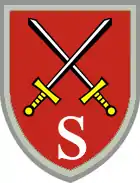 Coat of Arms of Aviation School | |
| Active | 1957–present |
| Country | Germany |
| Branch | German Army |
| Type | Army aviation |
| Role | Tactical Air Transport, Close Air Support, Reconnaissance, Liaison, Disaster Relief |
| Size | 6 regiments, 1 independent squadrons, 1 school |
| Motto(s) | Nach vorn To the front or Forward |
| Commanders | |
| Current commander | Brigadier General Ulrich Ott |
| Notable commanders | Colonel Horst Pape |
| Insignia | |
| Roundel | 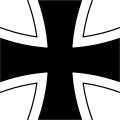 |
| Fin flash | |
| Cap badge |  |
| Collar patch | |
| APP-6A symbol |  |
| Aircraft flown | |
| Attack | Tiger |
| Trainer | H135 |
| Transport | NH90, Bell UH-1D |
Identification
The coat of arms of the German Army Aviation Corps depicts a white eagle, swooping down whilst carrying a sword in its claws. Members of the Army Aviation Corps wear a burgundy-coloured beret. The badge on the beret is a wing, crossed vertically by a sword, surrounded by oak leaves. The Waffenfarbe of the German Army Aviation Corps ( a means the German military uses to distinguish between different corps or troop functions in its armed services) is silver-grey. The epaulettes of members of the German Army Aviation corps are lined in silver-grey. The gorget patches are held in the same color with two vertical cords. The sleeves of the uniforms display the flying wings, emphasising their main task.
Tasks
The main tasks of the Army Aviation Corps are:
- support of own troops through anti-tank warfare.
- transport, both internally and externally, of personnel and material.
- reconnaissance in combination with other units.
- liaison between different units
- disaster relief, e.g. forest fires, floods etc.
Due to their manifold tasks, the German Army Aviation Corps cannot be classified as having any of the classic tasks of army units, namely leading and supporting the leadership, fighting and supporting the fighting force.[2]
Most units of the Army Aviation Corps are incorporated into the Airmobile Operations Division (Division Luftbewegliche Operationen). This division was founded on 1 July 2002 and became operational on 8 October 2002.
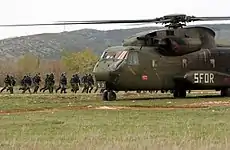
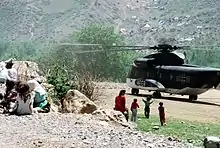
History
After the foundation of the Bundeswehr in 1955, the first head of the department of the German Army Aviation Corps, Colonel Horst Pape, was appointed on 7 November 1956. During the next ten years, a great number of bases all over the territory of the Federal Republic of Germany were founded.
In the first instance, all the equipment was acquired from allied nations. However, from the late 1960s onwards, more emphasis was put on developing new technology with other European partners. Until 1990, the German Army Aviation Corps was restricted to see active service only during aid mission within Germany and NATO countries.
Since the unification of the Federal Republic of Germany with the German Democratic Republic in 1990, there have been several rounds of re-organizations within the Bundeswehr, also affecting the German Army Aviation Corps. A number of bases were closed down, and their units either dissolved or merged with other units. In 2002, most remaining units of the German Army Aviation Corps were incorporated into the Airmobile Operations Division (Division Luftbewegliche Operationen) .
Furthermore, the role of the German Army Aviation Corps changed as well. Since the mid-1990s, it has been increasingly deployed in a support rôle in several countries for as varying bodies as the United Nations, NATO and the EU, first in Iraq after the 1st Gulf War, then on the Balkans with IFOR, KFOR, SFOR and EUFOR, and most recently in Afghanistan as part of ISAF and most recently in the Democratic Republic of the Congo as part of EUFOR RD Congo to support the UN mission MONUC to monitor the general elections in 2006. This mission began in June 2006 and ended with the last soldiers returning in December of the same year.
In October 2011 the German Federal Ministry of Defence announced a reorganisation/reduction of the German Armed Forces. As a consequence, the strength of Germany Army Aviation Corps will be reduced. Flying operations at a number of air bases will cease to exist and the respective units being dissolved. Other units will be transferred to the German Air Force.[3]
Equipment

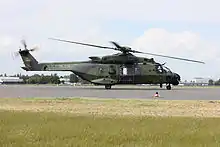
The German Army Aviation Corps is equipped with:
- Bell UH-1D, light transport helicopter.
- Eurocopter EC135, training helicopter.
- NH90, multi-role helicopter
- Eurocopter Tiger, attack helicopter
 Bell UH-1D
Bell UH-1D Bölkow Bo 105 P1A1
Bölkow Bo 105 P1A1
Units
The following units were subordinate to Airmobile Operations Division, the division's headquarters being in Veitshöchheim:
| Name of unit | Flying | Based at | Insignia | Note |
|---|---|---|---|---|
| Medium Transport Helicopter Regiment 15 Münsterland | Sikorsky CH-53G/GS | Rheine | Disbanded | |
| Medium Transport Helicopter Regiment 25 Oberschwaben | Sikorsky CH-53G/GS | Laupheim | Transferred to German Air Force | |
| Transport Helicopter Regiment 30 | Bell UH-1D | Niederstetten | ||
The following units were part of Airmobile Brigade 1 of Airmobile Operations Division. The division's headquarters was in Fritzlar:
| Name of unit | Flying | Based at | Insignia | Note |
|---|---|---|---|---|
| Light Transport Helicopter Regiment 10 Lüneburger Heide | NH90 | Faßberg | ||
| Attack Helicopter Regiment 26 Franken | MBB Bo 105P | Roth | Disbanded 30 June 2014[4] | |
| Attack Helicopter Regiment 36 Kurhessen | Eurocopter Tiger | Fritzlar | ||
The following unit was not part of the Airmobile Operations Division but part of Air Transport Wing 62:
| Name of unit | Flying | Based at | Insignia | Note |
|---|---|---|---|---|
| Army Aviation Support Squadron 1 | Bell UH-1D | Holzdorf | Disbanded 31 December 2013[5] | |
The following units operated independently:
| Name of unit | Flying | Based at | Insignia | Note |
|---|---|---|---|---|
| Army Aviation Maintenance Squadron 100 | Celle | Disbanded | ||
| Army Aviation Squadron 109 | Celle | Disbanded | ||
| Army Aviation Liaison and Reconnaissance Squadron 109 | MBB Bo 105M | Celle | Disbanded | |
The following units are or were part of the Army Aviation School. The school's headquarters is in Bückeburg:
| Name of unit | Based at | Insignia | Note |
|---|---|---|---|
| Instruction Group A (flying instruction) | Bückeburg | ||
| Instruction Group B (non-flying instruction) | Bückeburg | ||
| Training Centre C (flying instruction) | Celle | To be disbanded | |
| Army Aviation Test Squadron 910 | Bückeburg | Disbanded on 31 December 2008 | |
| Research And Development Group | Bückeburg | ||
| Technical Maintenance Department | Bückeburg | ||
| Franco-German Training Centre | Le Luc (France) | ||
References
- Militärisches Studienglossar Englisch – Teil II/III, p. 185
- Heeresfliegertruppe – Welchen Auftrag hat die Heeresfliegertruppe? (in German), German Federal Ministry of Defence, 7 August 2012, archived from the original on 5 December 2012, retrieved 19 January 2013
- Quoted from Bundesministerium der Verteidigung (26 October 2011), Neues Stationierungskonzept der Bundeswehr (in German), archived from the original on 8 November 2011, retrieved 5 November 2011, PDF-file "Die Stationierung der Bundeswehr in Deutschland", passim
- "Rother Heeresflieger sagen "Servus"", nordbayern.de, 23 July 2013, archived from the original on 5 September 2014, retrieved 18 February 2015
- Glückel, Sven (3 April 2013), "Staffel-Abwicklung ist wie ein Ende auf Raten", Lausitzer Rundschau, archived from the original on 18 February 2015, retrieved 18 February 2015
Further reading
- Bundesministerium der Verteidigung (1970), Heeresflieger, Bonn: Bundesministerium der Verteidigung
- Bundesministerium der Verteidigung (1975), Das Heer: Heeresflieger, Bonn: Bundesministerium der Verteidigung
- Bundesministerium der Verteidigung (2000). "Armee der Einheit 1990–2000" (PDF). Bundesministerium der Verteidigung. Retrieved 2010-10-08.
- Bundessprachenamt (ed.) (1993), Militärisches Studienglossar Englisch – Teil II/III, Bonn: Bundesministerium der VerteidigungCS1 maint: extra text: authors list (link)
- Bundeswehramt (1962), Unser Heer 3: Heeresflieger, Bad Godesberg: Bundeswehramt
- Fred, Bünz (1999). "Modernisierung in der Bundeswehr: die Entwicklung des Konzeptes der Luftbeweglichkeit und der entsprechenden Einsatzgrundsätze; unter besonderer Berücksichtigung des von Carl von Clausewitz formulierten Wechselverhältnisses von Theorie und Praxis". Diss. Universität der Bundeswehr München. Cite journal requires
|journal=(help) - Dressel, Joachim; Griel, Manfred (1990), Flugzeuge und Hubschrauber der Bundeswehr, Stuttgart: Motorbuch-Verlag, ISBN 3-613-01358-4
- Garben, Fritz (2005), Deutsche Heeresflieger: nationale und internationale Rettungs-, Hilfs- und UN-Einsätze, Lemwerder: Stedinger-Verlag, ISBN 3-927697-41-9
- Garben, Fritz (2006), Fünf Jahrzehnte Heeresflieger: Typen, Taktik und Geschichte, Lemwerder: Stedinger-Verlag, ISBN 3-927697-45-1
- Garben, Fritz (2007), Deutsche Heeresflieger: Techniker im Einsatz, Lemwerder: Stedinger-Verlag, ISBN 978-3-9276-9751-5
- Kaufholz, Bernd (2003), Im Dienste des "alten Europa": Helfer in Kabul und andernorts, Halle: mdv, ISBN 3-89812-202-6
- Rudolph, Christin-Desirëe (2012), Soldaten unterm Rotor: die Huschrauberverbände der Bundeswehr, Suttgart: Motorbuch-Verlag, ISBN 978-3-6130-3413-6
- Schütt, Kurt W. (1985), Heeresflieger: Truppengattung der dritten Dimension; die Geschichte der Heeresfliegertruppe der Bundeswehr, Koblenz: Bernard und Graefe, ISBN 3-7637-5451-2
- Bundesministerium der Verteidigung, ed. (1996), "Heeresflieger", 1000 Stichworte zur Bundeswehr, Mittler, ISBN 3-8132-0536-3
- Vetter, Bernd; Vetter, Frank (2001), Die deutschen Heeresflieger: Geschichte, Typen und Verbände, Stuttgart: Motorbuch-Verlag, ISBN 3-613-02146-3